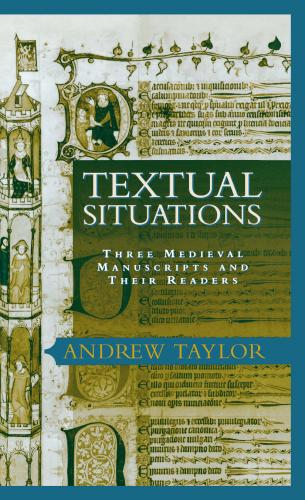Textual Situations
MATERIAL TEXTS
Series Editors
| Roger Chartier | Anthony Grafton |
| Joan DeJean | Janice A. Radway |
| Joseph Farrell | Peter Stallybrass |
A complete list of books in the series is available from the publisher.
Textual Situations
Three Medieval Manuscripts and Their Readers
Andrew Taylor
UNIVERSITY OF PENNSYLVANIA PRESS
Philadelphia
Copyright © 2002 University of Pennsylvania Press
All rights reserved
Printed on acid-free paper
10 9 8 7 6 5 4 3 2 1
Published by
University of Pennsylvania Press
Philadelphia, Pennsylvania 19104
Library of Congress Cataloging-in-Publication Data
Taylor, Andrew, 1958–
Textual situations : three medieval manuscripts and their readers / Andrew Taylor.
p. cm. — (Material texts)
ISBN 0-8122-3642-4 (alk. paper)
Includes bibliographical references and index.
1. Bodleian Library. Manuscript. Digby 23. 2. British Library. Manuscript. Harley 978. 3. Smithfield decretals. 4. Manuscripts, Medieval—England. 5. Books and reading—England—History—To 1500. 6. Literature, Medieval—Criticism, Textual. 7. Transmission of texts. 8. England—Intellectual life—1066–1485.
Z106.5.G7 T39 2002
| 091′.0942 dc21 | 2001047551 |
Contents
INTERSTICE: THE MINSTREL AND THE BOOK
3: BRITISH LIBRARY MS HARLEY 978
4: BRITISH LIBRARY MS ROYAL 10.E.4
Chapter 1
Medieval Materials
In contrast to the representation of the ideal, abstract text—which is stable because it is detached from all materiality, a representation elaborated by literature itself—it is essential to remember that no text exists outside of the support that enables it to be read.
—ROGER CHARTIER
Pour engager d’autres savants à faire des recherches de ce genre, en les étendant à tous les siècles et à toutes les variétés de sujets, il convient de parler à l’esprit et aux yeux, de décrire et montrer en même temps les objets chantés et dessinés.
To incite other scholars to conduct research of this kind, reaching out to them across the centuries and in all manner of subjects, we must appeal to the spirit and to the eyes, describing and showing at the same time these sung and drawn objects.
—ADOLPHE NAPOLEON DIDRON
The core of this book is devoted to an examination of three medieval manuscripts, the support that enabled a variety of texts to be read and performed. One is now in the Bodleian; the other two are now in the British Library. All three have been in southern England for centuries, but apart from this proximity they have little in common. The earliest, Bodleian MS Digby 23, is a small double volume consisting of two separate booklets, each dating from the twelfth century. One booklet contains Calcidius’s translation of the Timaeus; the other the best-known version of the poem now called La Chanson de Roland. The second manuscript, British Library MS Harley 978, is a slightly thicker volume, a miscellany dating from the mid-thirteenth century that contains an amazing range of material, including the Middle English lyric “Sumer Is Icumen In,” Latin satires and drinking songs, a long celebration of Simon de Montfort’s victory over Henry III at the Battle of Lewes in 1264, and works by the twelfth-century Anglo-Norman poet Marie de France—her translation of Aesop’s fables and her short romances, or lais, which explore the themes of amour courtois. The third manuscript, British Library MS Royal 10.E.4, copied in the early fourteenth century in Italy but later acquired by St. Bartholomew’s Priory in Smithfield, on what was then the outskirts of London, is by far the largest and most ornate, a handsome folio-sized copy of the Decretals of Pope Gregory IX, also known as the Liber extra, with an astonishing series of marginal illustrations that were added later in the century in England.
Many of the works these manuscripts preserve are well known; some, such as the Song of Roland, the lais of Marie de France, or “Sumer Is Icumen In,” are famous. The three manuscripts, however, have remained all but invisible, and it is part of my purpose to inquire why this should be so. Of course, editors may always choose to ignore one manuscript witness and concentrate on another, and the vast majority of medieval manuscripts languish unread for years. But this is not the problem here. “Sumer Is Icumen In” survives only in Harley 978, which also provides the base text for almost all editions of Marie’s lais and most editions of her fables, while it is the version of the Roland in Digby 23 that has come to represent the poem. Why then has the editorial construction of the Song of Roland and the Lais of Marie de France been conducted with such comprehensive disregard for the manuscripts from which these poems were extracted? Or, to turn to the last manuscript, why do the marginal drawings from the Smithfield copy of the Decretals of Gregory IX, which crop up again and again as illustrations of medieval wayfaring life, circulate without any connection to the legal text whose borders they decorate? In examining this curious invisibility, I hope to suggest something of the way in which the material support of the medieval text, which is not just the manuscript but also the social conventions that surround it, differs from that of the printed book.
It seems oddly fitting that the second epigraph that opens this chapter should come from such a peripheral position, the final sentence of a note by the editor, Adolphe Napoléon Didron, to an article by Viollet-Leduc, père, in the second volume of the Annales archéologiques, published in 1845—scarcely the place for a manifesto. In setting out his program for iconographie studies of medieval sculpture, painting, and poetry,
